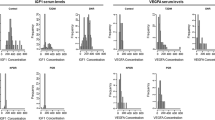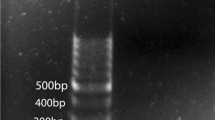Abstract
Background
The incidence of type 1 diabetes mellitus (T1DM) is increasing globally, and as a consequence, more patients are affected by microvascular complications such as diabetic retinopathy (DR). The aim of this study was to elucidate possible associations between diabetes-related single-nucleotide polymorphisms (SNP) and the development of DR.
Methods
Three hundred and thirty-nine patients with T1DM from the Danish Cohort of Pediatric Diabetes 1987 (DCPD1987) went through an ophthalmic examination in 1995; 185 of these were reexamined in 2011. The development of DR was assessed by comparison of overall DR level between baseline and follow-up in the worst eye at baseline. Patients were graded on a modified version of the Early Treatment Diabetic Retinopathy Study (ETDRS) scale, and 20 SNPs were genotyped in 130 of the 185 patients.
Results
We found the CTSH/rs3825932 variant (C > T) was associated with reduced risk of progression to proliferative diabetic retinopathy (PDR) (OR [95 % CI] = 0.20 [0.07–0.56], p = 2.4 × 10−3, padjust = 0.048) and ERBB3/rs2292239 variant (G > T) associated with increased risk of two-step progression (OR [95 % CI] = 2.76 [1.31–5.80], p = 7.5 × 10−3, padjust = 0.15). The associations were independent of other known risk factors, such as HbA1c, sex, and diastolic blood pressure.
Conclusion
In conclusion, CTSH/rs3825932 and ERBB3/rs2292239 SNPs were associated with reduced risk of progression to PDR and two-step progression of DR on the ETDRS scale accordingly. The variant CTSH remained statistically significant after adjusting for multiple testing. Our results suggest an overlap between genetic variants that confer risk of T1DM and progression of DR.
Similar content being viewed by others
Abbreviations
- T1DM:
-
Type 1 diabetes mellitus
- T2DM:
-
Type 2 diabetes mellitus
- DR:
-
Diabetic retinopathy
- PDR:
-
Proliferative diabetic retinopathy
- SNPs:
-
Single nucleotide polymorphisms
- OR:
-
Odds ratio
- CI:
-
Confidence interval
- BP:
-
Arterial blood pressure
- GWAS:
-
Genome-wide association study
- HWE:
-
Hardy-Weinberg equilibrium
- EURODIAB:
-
European Diabetes Study Group
- IDAA1c:
-
insulin dose-adjusted HbA1c
- CHR:
-
Chromosome
- MAF:
-
Minor allele frequency
- MAF_A:
-
Minor allele frequency calculated for the affected individuals (cases)
- MAF_U:
-
Minor allele frequency for the unaffected individuals (controls)
- Circ. VEGF:
-
Circulating vascular endothelial growth factor
- p adjust :
-
Adjusted p-value
- ETDRS:
-
Early Treatment Diabetic Retinopathy Study
References
Guariguata L (2012) By the numbers: new estimates from the IDF Diabetes Atlas update for 2012. Diabetes Res Clin Pract 98:524–525. doi:10.1016/j.diabres.2012.11.006
Olsen BS, Johannesen J, Sjølie AK et al (1999) Metabolic control and prevalence of microvascular complications in young Danish patients with Type 1 diabetes mellitus. Danish Study Group of Diabetes in childhood. Diabet Med J Br Diabet Assoc 16:79–85
The Eye Diseases Prevalence Research Group* (2004) The prevalence of diabetic retinopathy among adults in the United States. Arch Ophthalmol 122:552–563. doi:10.1001/archopht.122.4.552
Kobrin Klein BE (2007) Overview of epidemiologic studies of diabetic retinopathy. Ophthalmic Epidemiol 14:179–183. doi:10.1080/09286580701396720
Zheng Y, He M, Congdon N (2012) The worldwide epidemic of diabetic retinopathy. Indian J Ophthalmol 60:428. doi:10.4103/0301-4738.100542
Broe R, Rasmussen ML, Frydkjaer-Olsen U et al (2013) The 16-year incidence, progression and regression of diabetic retinopathy in a young population-based Danish cohort with type 1 diabetes mellitus: the Danish cohort of pediatric diabetes 1987 (DCPD1987). Acta Diabetol. doi:10.1007/s00592-013-0527-1
Kowluru RA, Santos JM, Mishra M (2013) Epigenetic modifications and diabetic retinopathy. BioMed Res Int 2013:1–9. doi:10.1155/2013/635284
McAuley AK, Wang JJ, Dirani M et al (2014) Replication of genetic Loci implicated in diabetic retinopathy. Invest Ophthalmol Vis Sci 55:1666–1671. doi:10.1167/iovs.13-13559
Looker HC, Nelson RG, Chew E et al (2007) Genome-wide linkage analyses to identify Loci for diabetic retinopathy. Diabetes 56:1160–1166. doi:10.2337/db06-1299
Keenan HA, Costacou T, Sun JK et al (2007) Clinical factors associated with resistance to microvascular complications in diabetic patients of extreme disease duration the 50-year medalist study. Diabetes Care 30:1995–1997. doi:10.2337/dc06-2222
Omar AF, Silva PS, Sun JK (2013) Genetics of diabetic retinopathy. Semin Ophthalmol 28:337–346. doi:10.3109/08820538.2013.825287
Ng DPK (2010) Human genetics of diabetic retinopathy: current perspectives. J Ophthalmol 2010, e172593. doi:10.1155/2010/172593
Kuo JZ, Wong TY, Rotter JI (2014) Challenges in elucidating the genetics of diabetic retinopathy. JAMA Ophthalmol 132:96–107. doi:10.1001/jamaophthalmol.2013.5024
Mortensen HB, Hartling SG, Petersen KE (1988) A nation-wide cross-sectional study of glycosylated haemoglobin in Danish children with type 1 diabetes. Diabet Med J Br Diabet Assoc 5:871–876
Mortensen HB, Marinelli K, Nørgaard K et al (1990) A nation-wide cross-sectional study of urinary albumin excretion rate, arterial blood pressure and blood glucose control in Danish children with type 1 diabetes mellitus. Danish Study Group of Diabetes in Childhood. Diabet Med J Br Diabet Assoc 7:887–897
Mortensen HB, Villumsen J, Vølund A et al (1992) Relationship between insulin injection regimen and metabolic control in young Danish type 1 diabetic patients. The Danish Study Group of Diabetes in Childhood. Diabet Med J Br Diabet Assoc 9:834–839
Mortensen HB, Hougaard P, Ibsen KK, Parving HH (1994) Relationship between blood pressure and urinary albumin excretion rate in young Danish type 1 diabetic patients: comparison to non-diabetic children. Danish Study Group of Diabetes in Childhood. Diabet Med J Br Diabet Assoc 11:155–161
Olsen BS, Sjølie AK, Hougaard P et al (2004) The significance of the prepubertal diabetes duration for the development of retinopathy and nephropathy in patients with type 1 diabetes. J Diabetes Complications 18:160–164. doi:10.1016/S1056-8727(03)00073-4
Aldington SJ, Kohner EM, Meuer S et al (1995) Methodology for retinal photography and assessment of diabetic retinopathy: the EURODIAB IDDM complications study. Diabetologia 38:437–444
National Eye Institute, Early Treatment Diabetic Retinopathy Study Research Group (1985) Early treatment diabetic retinopathy study (ETDRS): manual of operations. U.S. Dept. of Commerce, National Technical Information Service, [Springfield, Va.]
Early Treatment Diabetic Retinopathy Study Research Group (1991) Grading diabetic retinopathy from stereoscopic color fundus photographs--an extension of the modified Airlie House classification. ETDRS report number 10. Ophthalmology 98:786–806
Early Treatment Diabetic Retinopathy Study Research Group (1991) Fundus photographic risk factors for progression of diabetic retinopathy. ETDRS report number 12. Ophthalmology 98:823–833
Purcell S, Neale B, Todd-Brown K et al (2007) PLINK: a tool set for whole-genome association and population-based linkage analyses. Am J Hum Genet 81:559–575. doi:10.1086/519795
Reddy MVPL, Wang H, Liu S et al (2011) Association between type 1 diabetes and GWAS SNPs in the southeast US Caucasian population. Genes Immun 12:208–212. doi:10.1038/gene.2010.70
Fløyel T, Brorsson C, Nielsen LB et al (2014) CTSH regulates β-cell function and disease progression in newly diagnosed type 1 diabetes patients. Proc Natl Acad Sci 111:10305–10310. doi:10.1073/pnas.1402571111
Cooper JD, Smyth DJ, Smiles AM et al (2008) Meta-analysis of genome-wide association study data identifies additional type 1 diabetes loci. Nat Genet 40:1399–1401. doi:10.1038/ng.249
Eizirik DL, Sammeth M, Bouckenooghe T et al (2012) The human pancreatic islet transcriptome: expression of candidate genes for type 1 diabetes and the impact of pro-inflammatory cytokines. PLoS Genet 8, e1002552. doi:10.1371/journal.pgen.1002552
Cirman T, Oresić K, Mazovec GD et al (2004) Selective disruption of lysosomes in HeLa cells triggers apoptosis mediated by cleavage of Bid by multiple papain-like lysosomal cathepsins. J Biol Chem 279:3578–3587. doi:10.1074/jbc.M308347200
Conus S, Simon H-U (2008) Cathepsins: key modulators of cell death and inflammatory responses. Biochem Pharmacol 76:1374–1382. doi:10.1016/j.bcp.2008.07.041
Gocheva V, Chen X, Peters C et al (2010) Deletion of cathepsin H perturbs angiogenic switching, vascularization and growth of tumors in a mouse model of pancreatic islet cell cancer. Biol Chem 391:937–945. doi:10.1515/BC.2010.080
Hakonarson H, Qu H-Q, Bradfield JP et al (2008) A novel susceptibility locus for type 1 diabetes on Chr12q13 identified by a genome-wide association study. Diabetes 57:1143–1146. doi:10.2337/db07-1305
Wellcome Trust Case Control Consortium (2007) Genome-wide association study of 14,000 cases of seven common diseases and 3,000 shared controls. Nature 447:661–678. doi:10.1038/nature05911
Todd JA, Walker NM, Cooper JD et al (2007) Robust associations of four new chromosome regions from genome-wide analyses of type 1 diabetes. Nat Genet 39:857–864. doi:10.1038/ng2068
Wang H, Jin Y, Linga Reddy MVP et al (2010) Genetically dependent ERBB3 expression modulates antigen presenting cell function and type 1 diabetes risk. PLoS ONE 5, e11789. doi:10.1371/journal.pone.0011789
Roy MS, Hallman DM, Fu Y-P et al (2009) Assessment of 193 candidate genes for retinopathy in African Americans with type 1 diabetes. Arch Ophthalmol 127:605–612. doi:10.1001/archophthalmol.2009.48
Grassi MA, Tikhomirov A, Ramalingam S et al (2011) Genome-wide meta-analysis for severe diabetic retinopathy. Hum Mol Genet 20:2472–2481. doi:10.1093/hmg/ddr121
Rasmussen ML, Broe R, Frydkjaer-Olsen U et al (2014) Microaneurysm count as a predictor of long-term progression in diabetic retinopathy in young patients with type 1 diabetes: the Danish Cohort of Pediatric Diabetes 1987 (DCPD1987). Graefes Arch Clin Exp Ophthalmol Albrecht Von Graefes Arch Klin Exp Ophthalmol. doi:10.1007/s00417-014-2682-7
Tabor HK, Risch NJ, Myers RM (2002) Candidate-gene approaches for studying complex genetic traits: practical considerations. Nat Rev Genet 3:391–397. doi:10.1038/nrg796
Funding
The Beckett Foundation granted money for the genotyping.
Conflict of interest
Kristian Sandahl declare that he has received a research grant from Grosser Chr. Andersen og hustru Ingeborg Anders, f Schmidts legat. No other conflict of interest exists.
Statement of human and animal rights
All procedures followed were in accordance with the ethical standards of the responsible committee on human experimentation (institutional and national) and with the Helsinki Declaration of 1975, as revised in 2008.
Statement of informed consent
Informed consent was obtained from all patients for being included in the study.
Author information
Authors and Affiliations
Corresponding author
Additional information
Steffen U. Thorsen and Kristian Sandahl contributed equally to this work.
Electronic supplementary material
Below is the link to the electronic supplementary material.
Supplementary Table 1
(DOCX 36 kb)
Supplementary Table 2
(DOCX 35 kb)
Rights and permissions
About this article
Cite this article
Thorsen, S.U., Sandahl, K., Nielsen, L.B. et al. Polymorphisms in the CTSH gene may influence the progression of diabetic retinopathy: a candidate-gene study in the Danish Cohort of Pediatric Diabetes 1987 (DCPD1987). Graefes Arch Clin Exp Ophthalmol 253, 1959–1965 (2015). https://doi.org/10.1007/s00417-015-3118-8
Received:
Revised:
Accepted:
Published:
Issue Date:
DOI: https://doi.org/10.1007/s00417-015-3118-8




